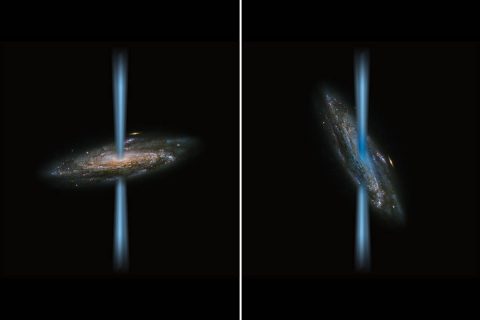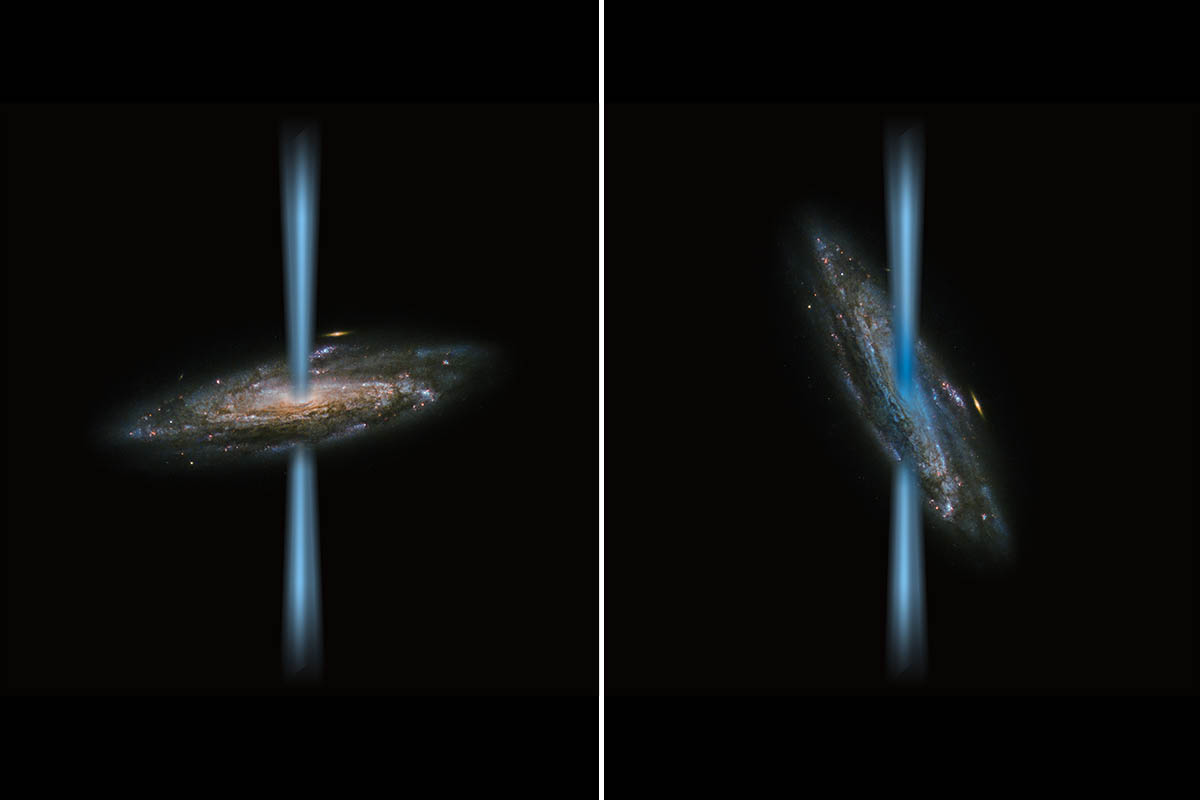 Washington, D.C. – Even celestial objects can seem like they’re playing tricks. In a new study, scientists are puzzled by a black hole that seems to be changing its galactic surroundings in a way that is usually associated with newborn stars.
Washington, D.C. – Even celestial objects can seem like they’re playing tricks. In a new study, scientists are puzzled by a black hole that seems to be changing its galactic surroundings in a way that is usually associated with newborn stars.
Black holes are inherently strange, with gravitational forces so strong that nothing, not even light, can escape. As active black holes consume gas and dust, some of that material is instead launched outward as jets of high-energy particles and radiation. Usually these jets are perpendicular to the host galaxy, but NASA’s Stratospheric Observatory for Infrared Astronomy, or SOFIA, found one that is shooting directly into its galaxy.

That jet is heating up gas around the galaxy’s center in a way that’s characteristic of stars being born. This is prompting scientists to reevaluate their ideas about a key gas associated with baby stars, and about how black holes affect their host galaxies generally.
“The black hole’s jet orientation is so peculiar,” said Irina Smirnova-Pinchukova, scientist at the Max Planck Institute for Astronomy in Heidelberg, Germany. “It transforms the surroundings in the same way newborn stars would, but stars alone could not cause what we observed.”
Stars are born deep inside celestial clouds of dust and gas, a process hidden from our view in visible light. But infrared light, which our eyes cannot see, can penetrate these clouds. SOFIA, for example, uses infrared light to study how stars are born.
But even with powerful telescopes, astronomers cannot see details like newborn stars in extremely distant galaxies. Instead, they hunt for signatures of gas that is heated by newborn stars, called ionized carbon. Because ionized carbon is so often found in connection with newborn stars, scientists often assume star formation is occurring when they find the gas in distant galaxies.
But when scientists on SOFIA studied five nearby galaxies with active black holes, they discovered that the one with the lowest rate of star birth contained the most ionized carbon. In fact, there was 10 times more than in other galaxies of similar size and composition.
But the star birth rate is so low that it can only produce 25% of the gas they detected. In other words, newborn stars alone could not explain the abundance of ionized carbon. There must be some other explanation for this important chemical signature.
The team used SOFIA’s instrument called the Field Imaging Far-Infrared Line Spectrometer, or FIFI-LS, to closely examine the galaxy, HE 1353-1917. They found that the black hole’s jet is shooting radiation directly into the galaxy, rather than into the space surrounding it. Most of the ionized carbon is concentrated near the galaxy’s active black hole, indicating that the mysterious source of the gas is the intense radiation the black hole’s jet generates.
This contradicts the long-held assumption that ionized carbon is primarily a signature of newborn stars. The results are published in the journal Astronomy and Astrophysics.
Information from nearby galaxies, such as how black holes can create ionized carbon and affect a galaxy’s subsequent evolution, are crucial for understanding the data from other observatories including the Atacama Large Millimeter/submillimeter Array, or ALMA observatory, in Chile. Radio telescopes like ALMA study some of the most distant and faint galaxies, which are often so far away that even powerful telescopes can only detect them as a point of light.
That light is full of information, but details about nearby galaxies gathered by SOFIA are required to interpret data from the most distant regions of the universe. Now scientists know that high levels of ionized carbon in a distant galaxy may indicate not only that a lot of stars are being born, but also that a black hole’s jet may be responsible for the same kinds of chemical signatures.
SOFIA, the Stratospheric Observatory for Infrared Astronomy, is a Boeing 747SP jetliner modified to carry a 106-inch diameter telescope. It is a joint project of NASA and the German Aerospace Center, DLR. NASA’s Ames Research Center in California’s Silicon Valley manages the SOFIA program, science and mission operations in cooperation with the Universities Space Research Association headquartered in Columbia, Maryland, and the German SOFIA Institute (DSI) at the University of Stuttgart.
The aircraft is maintained and operated from NASA’s Armstrong Flight Research Center Building 703, in Palmdale, California.



